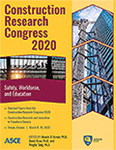Construction Research Congress 2020
Evaluation of Air Pollutants in Nonroad Diesel Construction Equipment Cabs
Publication: Construction Research Congress 2020: Safety, Workforce, and Education
ABSTRACT
Previous research indicates that air quality near the cabs of nonroad diesel equipment may exceed recommended exposure limits for certain pollutants. The objective of this case study was to collect and analyze air pollutant data near the cabs of nonroad diesel equipment while performing real-world activities. Using state-of-the-art instrumentation, the research team conducted 24 tests on nine different items of nonroad equipment. The team collected data related to pollutant concentrations of carbon monoxide, carbon dioxide, nitric oxide, nitrogen dioxide, particulate matter, and black carbon. Average concentrations of carbon monoxide and nitric oxide did not exceed published exposure limits on a consistent basis, but their maximum values occasionally exceeded the limits. Carbon dioxide concentrations frequently exceeded recommended levels for adequate ventilation. The most concerning results belonged to particulate matter and black carbon. Concentrations of respirable particulates often exceeded recommended levels on a sustained basis. Overall, the case study yielded enough information to conclude that studying near-cab air quality in nonroad equipment cabs is necessary to reduce hazards related to human health, safety, and productivity for equipment operators.
Get full access to this article
View all available purchase options and get full access to this chapter.
ACKNOWLEDGEMENT
The U.S. Department of Transportation University Transportation Centers Program and the Center for Advancing Research in Transportation Emissions, Energy, and Health (CARTEEH) funded this research in whole under Project Number TTI-01-11.
REFERENCES
1.
United States Environmental Protection Agency (2019). “Introduction to Indoor Air Quality” https://www.epa.gov/indoor-air-quality-iaq/introduction-indoor-air-quality, Information viewed on August 1, 2019.
2.
Health Canada: Health Protection Branch. (1989). “Exposure guidelines for residential indoor air quality.” Ottawa, Ontario.
3.
Willem, H. C., Tham, K. W., Wargocki, P., Wyon, D. P., & Fanger, P. O. (2006). “Effects of outdoor air supply rates on subjective factors in three call centers in the Tropics: a principal component analysis approach.” Proc., Healthy Buildings.
4.
Canadian Centre for Occupational Health and Safety (2017) “Carbon Monoxide: OSH Answers.” http://www.ccohs.ca/oshanswers/chemicals/chem_profiles/carbon_monoxide.html. Information viewed on August 1, 2019.
5.
Martoft, L., Stødkilde-Jørgensen, H., Forslid, A., Pedersen, H. D., & Jørgensen, P. F. (2016). “CO2 induced acute respiratory acidosis and brain tissue intracellular pH: a 31P NMR study in swine,” Laboratory Animals, 37(3), 241–248.
6.
United States Environmental Protection Agency (1991). “Building Air Quality: A Guide for Building Owners and Facility Managers.” Washington, D.C.
7.
New Jersey Department of Health. (2009). “Hazardous substance fact sheet: Nitric oxide.” Retrieved from https://nj.gov/health/eoh/rtkweb/documents/fs/1357.pdf.
8.
Environmental Protection Agency Center for Corporate Climate Leadership. (2016). “Greenhouse gas inventory guidance: Direct emissions from mobile combustion sources.” Retrieved from https://www.epa.gov/sites/production/files/2016-03/documents/mobileemissions_3_2016.pdf.
9.
Occupational Safety and Health Administration. (2018). “Permissible exposure limits: OSHA annotated table Z-1.” Retrieved from https://www.osha.gov/dsg/annotated-pels/tablez-1.html.
10.
Environmental Protection Agency. (2018). “Report on the environment: Nitrogen oxides emissions.” Retrieved from https://cfpub.epa.gov/roe/indicator_pdf.cfm?i=15.
11.
United States Environmental Protection Agency (2015). “Air Quality Designations for the 2012 Primary Annual Fine Particles (PM2.5) National Ambient Air Quality Standards (NAAQS) Final Rule.” 80(10), Washington, D.C.
12.
United States Environmental Protection Agency (2009). “2009 Final Report: Integrated Science Assessment for Particulate Matter.” Washington, D.C.
13.
Diesel Technology Forum. (2019). “Climate change, black carbon and clean diesel.” https://www.dieselforum.org/policy/climate-change-black-carbon-and-clean-diesel. Information viewed August 1, 2019.
14.
Environmental Protection Agency. (2019). “Black Carbon: Basic Information.” https://www3.epa.gov/airquality/blackcarbon/basic.html#trends. Information viewed on August 1, 2019.
15.
Health Canada: Health Protection Branch. (1989). “Exposure guidelines for residential indoor air quality.” Ottawa, Ontario.
Information & Authors
Information
Published In
Construction Research Congress 2020: Safety, Workforce, and Education
Pages: 608 - 615
Editors: Mounir El Asmar, Ph.D., Arizona State University, David Grau, Ph.D., Arizona State University, and Pingbo Tang, Ph.D., Arizona State University
ISBN (Online): 978-0-7844-8287-2
Copyright
© 2020 American Society of Civil Engineers.
History
Published online: Nov 9, 2020
Published in print: Nov 9, 2020
Authors
Metrics & Citations
Metrics
Citations
Download citation
If you have the appropriate software installed, you can download article citation data to the citation manager of your choice. Simply select your manager software from the list below and click Download.
